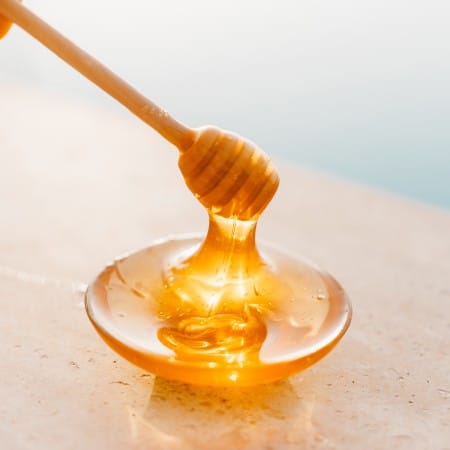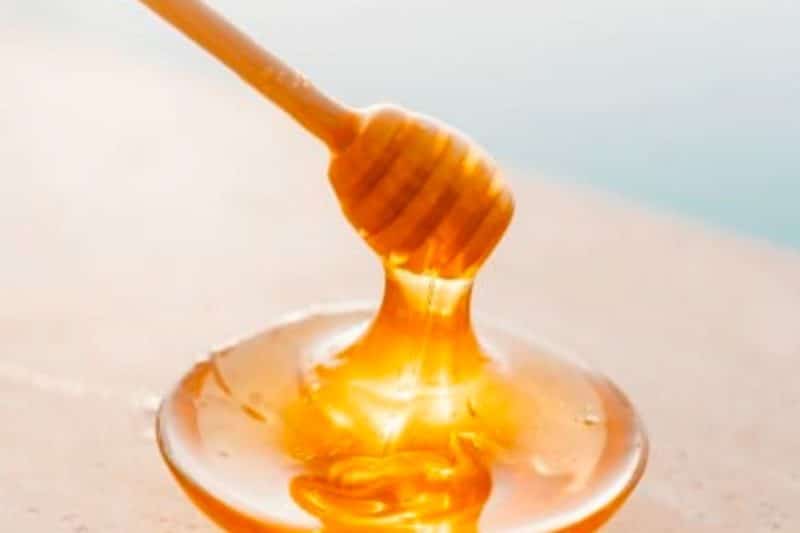September usually marks the end of honey collection for beekeepers across the country, and because of that, it is recognized as National Honey Month. Autumn is officially here, and with it come cooler nights, warm drinks, + cozy dishes. Honey is the magical substance that makes everything sweeter. From adding honey to warm tea, to drizzling it on our toast, to using it in stews, marinades, and dressings, honey offers an incredibly delicious (and healthy) alternative sweetener to sugar. Most people know that honey comes from bees, but the process is a little more complex than one might think. We’ve rounded up everything you need to know about honey — as well as some local, sustainable apiaries + beekeeping farms in New Jersey. Read on to learn all about the honey-making process and where you can find local honey farms in New Jersey.

The Facts
Honey is a highly concentrated water solution of two sugars, fructose, and glucose, with small amounts of other complex sugars. There are many types of honey, each with its own unique texture, flavor profile, and aroma. Honey never spoils — only crystalizes — and its many health benefits and antibacterial properties make it a force to bee reckoned with (sorry, we had to). Although the top honey-producing states are California, Florida, and South Dakota, New Jersey has a large number of bee and honey farms that create high-quality, local + raw honey. In fact, the climate and temperature of New Jersey provide a great habitat for raising and managing honey bees. Plus, there is a bountiful amount of flora found here from which the bees can extract nectar.
Read More: A Guide to Flower Farms in New Jersey
The Worker Bees
New Jersey honey is primarily produced by Italian honey bees (Apis mellifera ligustica), Carniolan honey bees (Apis mellifera carnica), and Russian Hybrids. These are all subspecies of the Western honey bee. Each bee hive has 3 “genders” of bees: Queens, Workers, and Drones. Female bees are called “worker bees” or “foragers” and they are responsible for collecting the nectar, pollen, and doing all the work of maintaining the hive. Worker bees transform the floral nectar into honey by adding enzymes to the nectar and reducing the moisture. Worker bees dedicate their lives to serving the colony. They forage the area and travel flower to flower — usually the same type — collecting nectar. Worker bees make honey so the colony has food to eat in the winter.

Did you know: According to the National Honey Board, worker bees must visit about two million flowers to make one pound of honey. To visit 2 million flowers, bees need to fly 55,000 miles, which is twice around the earth. A standard jar of honey requires bees to make one million flower visits and a colony produces an average of 50 to 100 jars per year. In addition to honey, Bees produce many things that directly benefit humans, such as wax, resins, propolis, and royal jelly. Interestingly enough, honey bees pollinate 1/3 of the human diet.
The Honey-Making Process
The process of making honey begins with the worker bees who extract nectar from millions of blooming plants and flowers. They do so by sucking the flowers with their long tongues and storing it in their abdomen called the ‘honey stomach.’ The bees then return to their hives and pass the nectar on to the younger worker bees, who begin the conversion of nectar to honey. Here, they extract and break down the nectar into simpler compounds and add additional enzymes to the nectar. This further modifies the pH of the money — and sugars molecules change during the process — until it becomes a very acidic product. Next, the bees use their wings to remove excess moisture and seal the cells. Over time, the nectar creates binds with enzymes and wax, ultimately creating its characteristic sweet flavor. In the final stages, Beekeepers step in to remove any remaining wax. After allowing the honey to rest for a few days, the product (raw honey) is packaged directly.
The Different Types of Honey
Honey gets its color, flavor, and odor from the nectar of flowers that the worker bees visit. The lighter the honey color, the more delicate and mild its taste — and the darker the honey, the stronger the flavor. There are as many types of honey as there are different types of flowers. In fact, it is estimated that there are more than 300 unique types of honey commercially available in the United States.

Consequently, there are certain types of honey that stand out for their superb flavor or medicinal qualities. These include Sourwood Honey, Tupelo Honey, Blueberry Honey, Orange Blossom Honey, Raspberry Honey, Buckwheat Honey, Acacia Honey, and Clover Honey — to name a few. In New Jersey, the most common types of honey include: Blueberry Honey, Black Locust Honey, Clover Honey, Goldenrod Honey, Cranberry Honey, Linden Honey, Alfalfa Honey, Aster Honey, Knotweed Honey, Tulip Poplar Honey, Buckwheat Honey, and Wildflower Honey.
Benefits of Honey
Historically, honey has been viewed more as a medicine than as a food. In WWI, before penicillin was discovered, honey was used to heal wounds. Today, it continues to be known as Mother Nature’s remedy for just about everything and contains numerous health benefits. For instance, studies show that honey improves cardiovascular health, stimulates fast wound healing, reduces scarring, and is extremely effective against persistent coughs + sore throats, or other viral-borne diseases. In addition, it is said to help with headaches and colds, is rich in iron + antioxidants, acts as an anti-inflammatory, improves liver function, helps the digestive tract, builds immunity, and may even alleviate seasonal allergy symptoms.
Raw Honey vs Regular Honey vs Organic
Raw honey is unique in that it comes straight from the honeycomb. Beekeepers filter the honey to remove small bits of debris, including pollen, beeswax, and parts of dead bees. There is no pasteurization, or heat treatment, involved. Raw honey appears cloudy or opaque because it contains these extra elements — however, it is still safe to eat.
Pasteurized honey is very clear and smooth. The pasteurization improves the honey’s appearance, increases its shelf-life, and kills yeast cells that can affect the taste of the honey. However, it is believed that pasteurization reduces the number of antioxidants and nutrients in honey. This type of processed honey may also contain unwanted additives, sugars, and sweeteners.
Organic honey is collected from organic certified beehives and blossoms that have not been exposed to herbicides or pesticides. As a result, organic honey is free from additives, preservatives, and chemicals. However, if honey is labeled as organic, that does not automatically indicate that it is also raw.
Support Local Honey

Many beekeepers sell their honey products on site, in stores or farmers’ markets, and online. In addition to honey, beekeepers produce lotions, soaps, chapsticks, spreads, and more from their hives. For many, it’s a family operation, and some go back several generations. Shopping at local farms is also a more sustainable and ethical practice, where bees are not overworked and carbon footprints are typically lower. Plus, at small farms, beekeepers take only the surplus of honey that bees make, which helps alleviate weight from the hive and prevents it from collapsing. Local beekeepers also help keep bees safe from predators and protected against harsh weather environments.
See More: LifeCap Farms: A Sustainable Urban Mushroom Farm in Jersey City
Some of New Jersey’s local apiaries include:
- Stewart’s Apiaries — Dorothy
- Schuler’s Honey — Richland
- Bee Flower and Sun Honey Company — Milford
- Beehive Barn — Cranbury
- Blueberry Wood Apiary — Jackson
- Bountiful Bees of Broad Street — Hightstown
- Cape May Honey Farm — Cape May
- Gooserock Farm — Montville
- Hilltop Honey — North Caldwell
- Lakeview Apiary — Lake Hopatcong
- Sweet Cheeks Farm and Apiary — Chester
- Uncle Gordon’s Backyard Honey — North Bergen
- Abma’s Farm — Wyckoff
- Campgaw Bees — Franklin Lakes
- Mountain Man Sweets — Garfield
- Neshanic Station Apiaries — Branchburg
- Alstede Farms — Chester
- Gooserock Farm LLC — Boonton
- Tanis Apiaries — Pompton Plains
- Wolgast Tree Farm — Somerset
- Tulasi Honey — Park Ridge
- E&M Gold Beekeepers — Tinton Falls
- Honey Creek Farm — Green Township
- Pointer Bee Farm — Rahway
- Dr. B’s Wild Honey — West Orange
- Do Re Bee Honey Farm — Marlboro
- Frank’s Honey — Ridgewood
- Mayflower Honey Farm — Monmouth Junction
- Sahabee Honey — Linden
- Honey Hound Farm — Wantage
- Hank’s Hollow Honey — Milford













